The Article
HW-40 Anniversary Turntable From VPI
26th April 2019
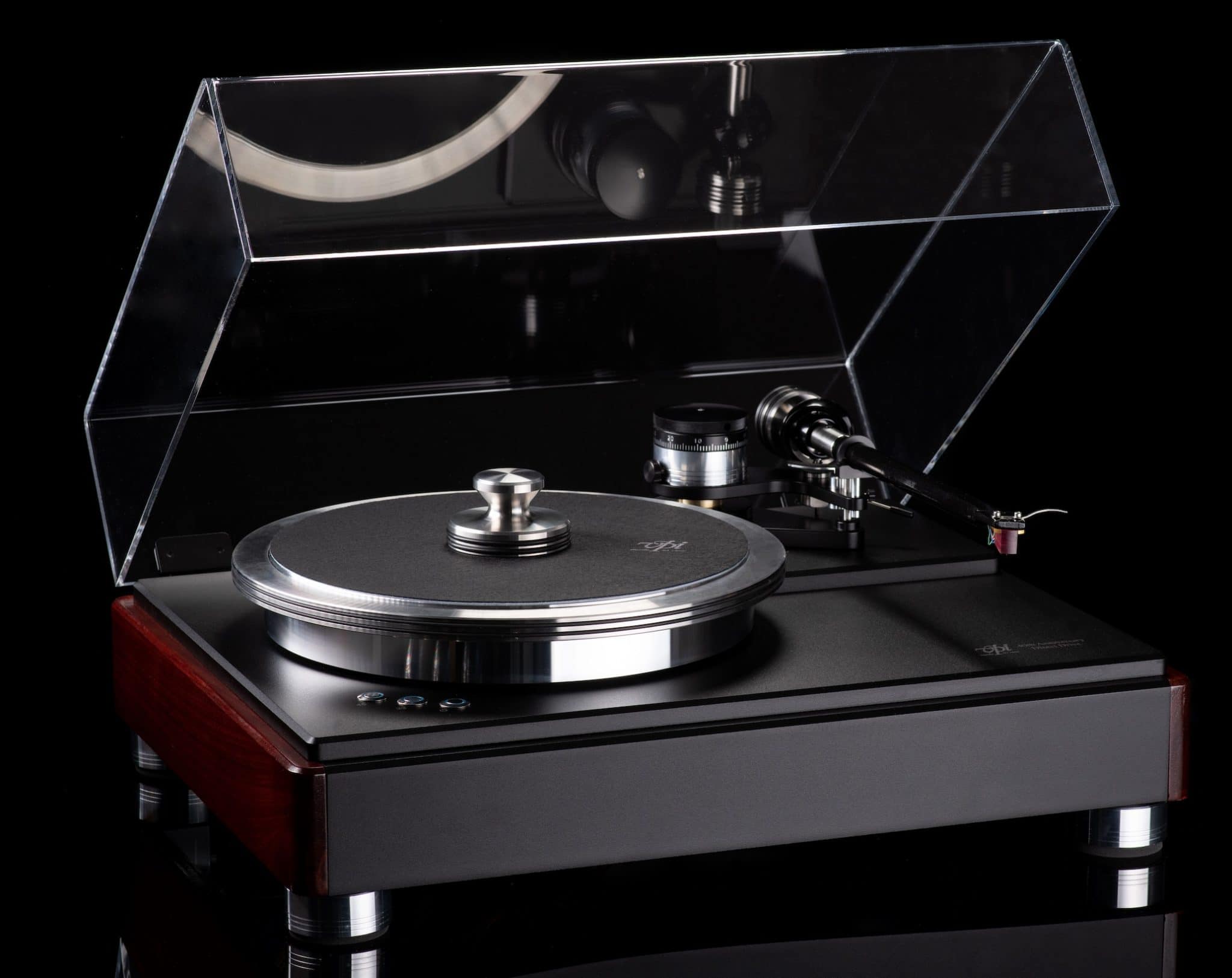
A limited-edition direct drive turntable design, Paul Rigby reviews the HW-40 in its ‘Anniversary’ configuration
This is a big turntable. The plinth is large and imposing. You could throw two jumpers on one end of this thing for goalposts, climb on top and play football on it, for goodness sake.
I wasn’t sure if this was a turntable or a writing desk.
Some of you might recognise it because there was an earlier incarnation of this design from 2012 called the Classic Direct Drive Signature turntable. It was much more expensive but not as sophisticated. When I say that, I’m looking at the motor. Don’t confuse that older model with this freshly baked variant.
To business and let’s look at that plinth size on a practical level. This turntable will reach the end limits of standard-sized hi-fi shelving so be prepared when installing that you have the room and make sure there’s space around it too in case your room is a bit on the cramped side.
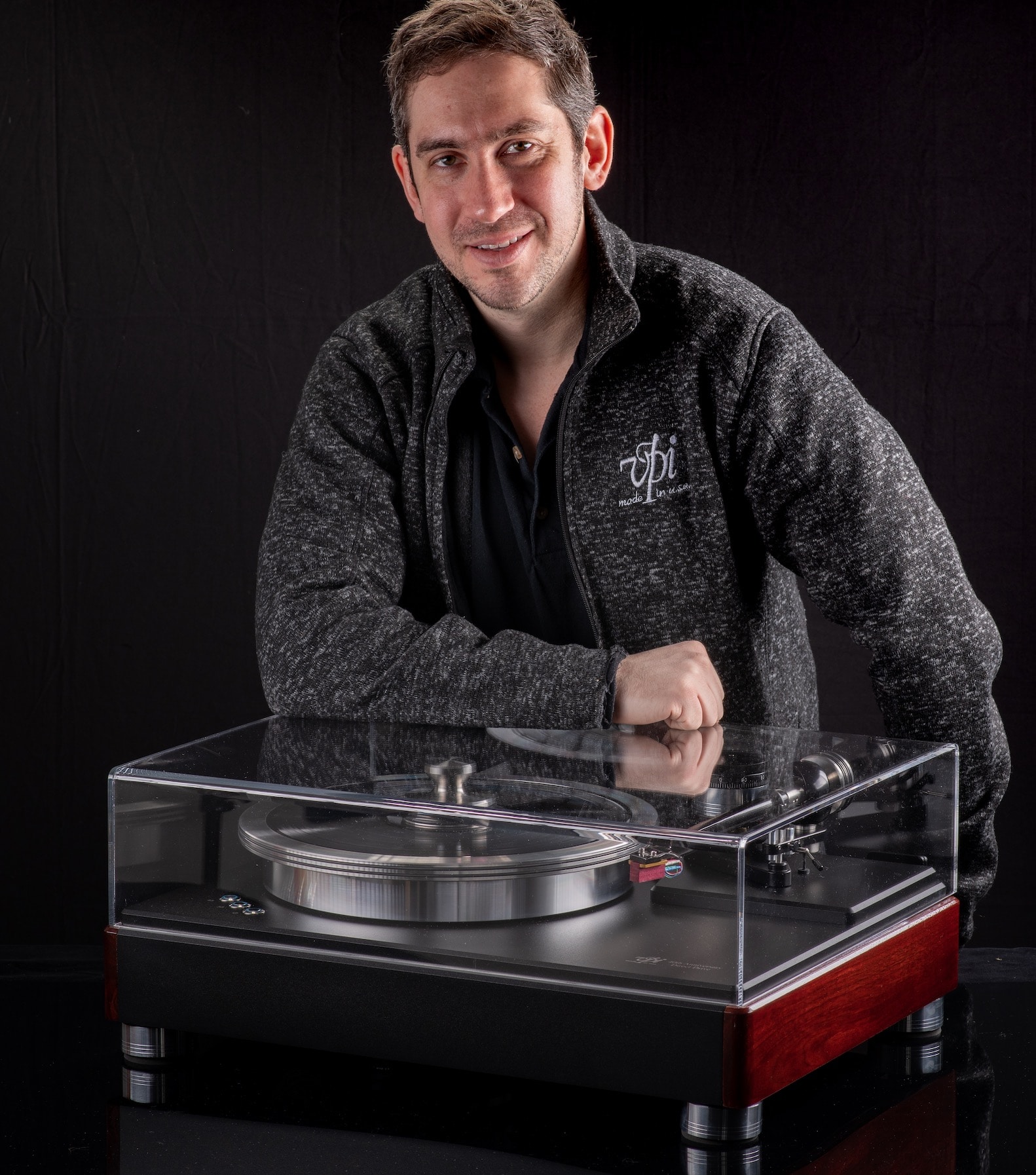
If you think the deck might hit the corners of your shelf then be aware if you have a shelf that features bobbly/knobbly fastenings on each corner to tie the rack system together. Not all top shelf hi-fi racks are clear and obstruction free. In this case, you might be best to rest the entire deck on tall isolation feet to lift the VPI up and away from those troublesome corners.
Suggested models might be the Alto Extremo Lyd II feet and the Orea Indigo Isolation feet from Isoacoustics
When the HW-40 Anniversary does sit finally on the shelf though it imposes and dominates your hi-fi and the room, come to that. But it does so with elegance and style (and an underlying tone of brute strength).
The technical reason for the size of the plinth is because it holds the electronics and motor. To confirm then, unlike other turntables out there, the HW-40 Anniversary is an enclosed system. There is no external and separate motor pod or power supply.
MASS DAMPING
Now, a little warning light might have just lit inside your head which asks the question, “If all of this resonating hardware is sitting inside the plinth, surely it will transfer a host of harmful noise to the rest of the system?” Which is why VPI has produced a massy and heavy plinth structure to damp the entire thing. The large plinth needs to support around 14kg of platter and ring clamp (see below). More mass damping. You don’t want that heavy weight sitting on a light plinth. That situation won’t end well. The size of the plinth also allows VPI to design an isolated system within to reduce noise. There’s one more reason for the size of the turntable, to accommodate the 12″ tonearm (see below).
This turntable design is intriguing and also rare. Rare because only 400 VPI HW-40 Anniversary turntables will be produced and intriguing because the design is based upon direct drive technology.
VPI takes a wholly different pathway when approaching the direct drive direction. Most turntable fans will appreciate that direct drive traditionally involves a high torque platter action. One that boosts bass and enhances timing with on-the-nail transient performance. The issue with the popular Technics system, for example, is that this high torque approach can be a recipe to store energy in the platter itself which can produce noise, picked up by the cartridge.
The VPI also offers a high torque motor to drive the very heavy aluminium platter (at 12.25kg) but it avoids platter energy storage by moving the platter using 2,500 tiny pulses per revolution (at 33⅓rpm). It also does this without any threat of cogging (a direct drive disease that used to be a feature of ye olde Technics turntables). This means that you never have a single, massive push of energy infusing the platter area. It’s like a million ants each giving the thing a tiny heave. On their own, they’re useless, get them all together and they can move mountains.
KEEP YOUR BEARINGS
The motor is controlled using a servo amplifier to monitor the speed of the platter. You’ll find that the platter hits the required speed very quickly. Once the heavy platter is up to speed, the energy is reduced and the servo is left to maintain the speed with a much reduced energy output. The entire operation is, it has to be said, very quiet indeed.
The platter features an inverted bearing with the thrust bowl sitting on top of the bearing spindle that then sits on a thrust pad made from PEEK (Polyetheretherketone). It’s inverted because, according to VPI, “…the point of contact between the thrust pad and the ball bearing is at the same level as the tracking stylus. This means there is minimal movement and mechanical resonance. If the bearing is down in the well of the plinth, the structure is swaying on top if it. The issue with an inverted bearing is that you need a tall platter to accommodate them.” And that’s what we have here.
There’s a phosphor bronze insert/lining, while the spindle and ball bearing are stainless steel.
Speaking of the platter, the outer lip features a small cut out. This is positioned to allow the record to lie perfectly flat on the platter. You’ll also see in the image above a removable “peripheral ring clamp” which surrounds the platter and covers the end of the record. That is, you place the record on the platter and the ring clamp on the record. It includes felt pads to prevent damage. The ring doesn’t touch the platter.
All of this means that your 180gm vinyl record pressing has been transformed into a 12.25kg record pressing. The ring clamp also acts as a flywheel to turn your 12” record into a 14” record.
The final addition to the turntable is the stabiliser accessory, which sits loosely over the centre spindle.
ARM IN ARM
The 12” JMW-12 Fatboy tonearm was selected because of the classic low tracking angle error aspect of the design. One of my reference turntables features a 12” arm and I can vouch for this benefit. It also meant that the headshell angle could be reduced.
There’s a related issue here though and one that VPI had to tackle promptly. The longer the arm tube, the greater the inherent design resonances. It’s a bit like twanging a ruler on the edge of a desk – the longer the ruler, the more twang you get. This is how I spent most of my time at school, so I know what I’m talking about here. This is also why most manufacturers use a 9” tonearm. To reduce those resonances.
To counter the downsides of a longer arm tube, you need to almost over-engineer the tube. VPI likes its unipivots but this is a gimbal bearing design so a different build approach was required.
The tube itself and headshell is a single piece, there are no mechanical interfaces here. This section of the tonearm is 3D printed. It begins flat in shape and tapers to a cylinder the further back it flows. According to VPI, this is to reduce standing and resonance waves. One thing to note here, 3D printing allows you to shape the inside of the tube as well as the outside. I’ve never heard anyone talk about this before but VPI made a point of noting it and, to be honest, it’s a great point. When a metal tube is utilised, for example, you’re really stuck with the starting former and then you shape it from there, “The inside of most production tonearm wands, varies,” confirmed VPI. “No-one can rework the inside of it whereas, with 3D, you have full control of that.”
VPI has produced fully 3D-printed tonearms before which is fine for a unipivot. A gimbal arm needs great strength in and around it though, hence the use of metal at the rear of the arm construction. Stainless steel is used for the core of the tonearm. Nordost wire is used within, “They give us ultra-low capacitance cables,” said VPI. “If there was an appreciative capacitance here then you would have to adjust that in the phono stage and there are precious few phono stages out there that will allow you to make that required capacitance adjustment.” The bearing is a Japanese-sourced ABEC-9, a known and well-liked bearing grade.
VTA
The counterweight is added to the rear of the arm and locked into place. From there, it is moved by a threaded adjustment at the rear. A free stylus tracking force gauge is included.
To the left of the arm is a large VTA (Vertical Tracking Angle) adjustment wheel. I just loved this. I played around with it for ages during the review because it was so easy to use. It allowed me to not only tweak the VTA very easily for different cartridges but also for different vinyl thicknesses. Takes a few seconds to adjust too. Tweakers will absolutely adore it.
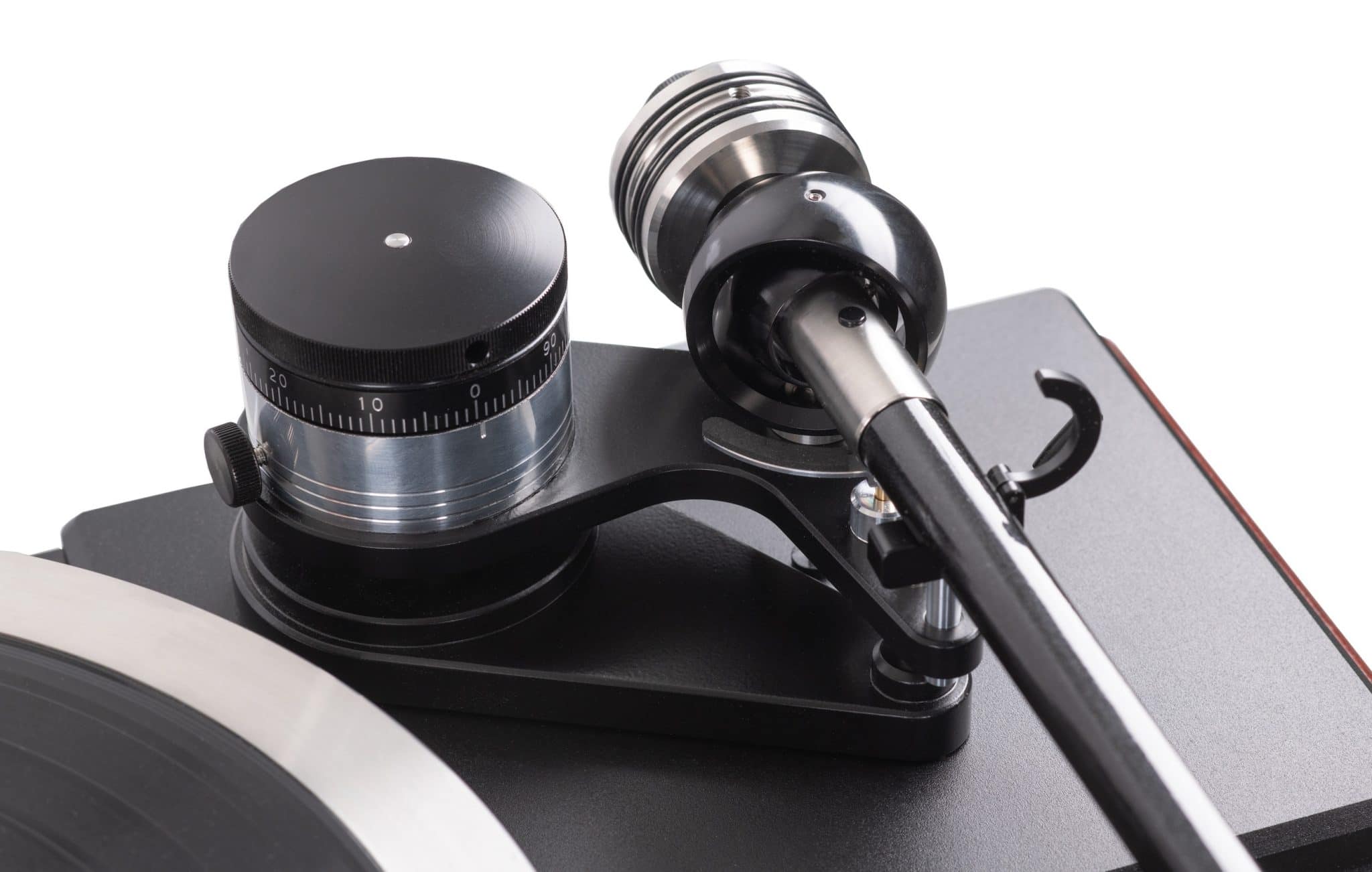
You can also adjust the azimuth on the arm. The headshell features a small slot which holds a supplied removable metal bar to allow you a visual indication for the measurement. There are a couple of grub screws on the silver collar of the arm to facilitate movement.
VPI asks you to supply your own phono cables and power cables. I’m happy with this because it forces you to consider this area instead of defaulting to the execrable kettle lead that’s normally supplied in most turntable boxes. Don’t forget, you’re spending £15,000 – that’s fifteen thousand pounds, do I need to translate this into French and German? I emphasise this point to ask this question: do you really want to connect this important and expensive piece of technology with a 5p mains cable and bell wire costing somewhere in the region of 0.0001p? Use high-end cabling only for this area. The best you can afford. In fact, save up for better. So allow for that in your budget.
A dustcover is supplied as are the rather lovely wooden cheeks to the left and right of the plinth.
The adjustable, isolating feet below also move to cater for slightly uneven surfaces.
SOUND QUALITY
I grabbed the vinyl version of Nancy Wilson’s You’ve Got Your Troubles from the original Capitol/EMI pressing of A Touch of Today (1966). And yes, she sure does have problems because this master is almost – but not quite – strident. It’s on the verge of plain old bright. The cut is a useful test track though because you immediately present the hi-fi component with imminent catastrophe and then you see how it copes. Anything forward of neutral will cause brightness. Anything much less will dull the mids.
So how did the HW-40 Anniversary react?
If I said, “Wow!” right now, could we all go home so that you could all just leave me alone to listen to my record collection on this thing?
No, I had a feeling you might say that.
Where to start? Well, “Wow!” is actually a logical beginning because we all tend to react to the whole sound when we first listen to any hi-fi component. It’s only after that initial impression do we begin to investigate the ingredients of the sound output.
So what of that “Wow!” then? Why “Wow!”? My first impression was based upon a number of seemingly conflicting and contrasting emotions combined with a large spreadsheet full of information.
The emotional side of me said this, “This is nice. No, no, it’s very nice and we should just sit here and bathe in this stuff. Really, do it now. Don’t make any notes, just listen.” That came from the sense of initial neutrality combined with an insight that produced a Tsunami of fine detail. Hence, instead of making lots of notes, I was compelled (or was it stunned) to listen only and then the details started to spring forth. New elements that surprised me from this familiar track.
I say new elements, I don’t mean that new instruments emerged from the mix but rather that the sounds presented themselves with a level of sonic maturity that both excited and took the breath away.
The sound presented a balanced output on a broad level. That meant the HW-40 Anniversary was behaving itself. Bass, midrange and treble did their jobs, didn’t try to dominate any aspect of the soundstage, performed to spec and never faltered. No bass bloom, no treble pinch and zero smearing in the mids. To achieve this level of frequency competence is hard for any hi-fi component but it is absolutely critical if you want your sound to impress. Frequency discipline is your base line. You have to get this right. Cock up this part of the sound and you just can’t fix things down the line. This is why you sometimes get turntables which sound really impressive in terms of bass but feature recessed mids or the treble is exquisite but the bass is absent without leave. Get your basics right and you can build upon that to, who knows, great things.
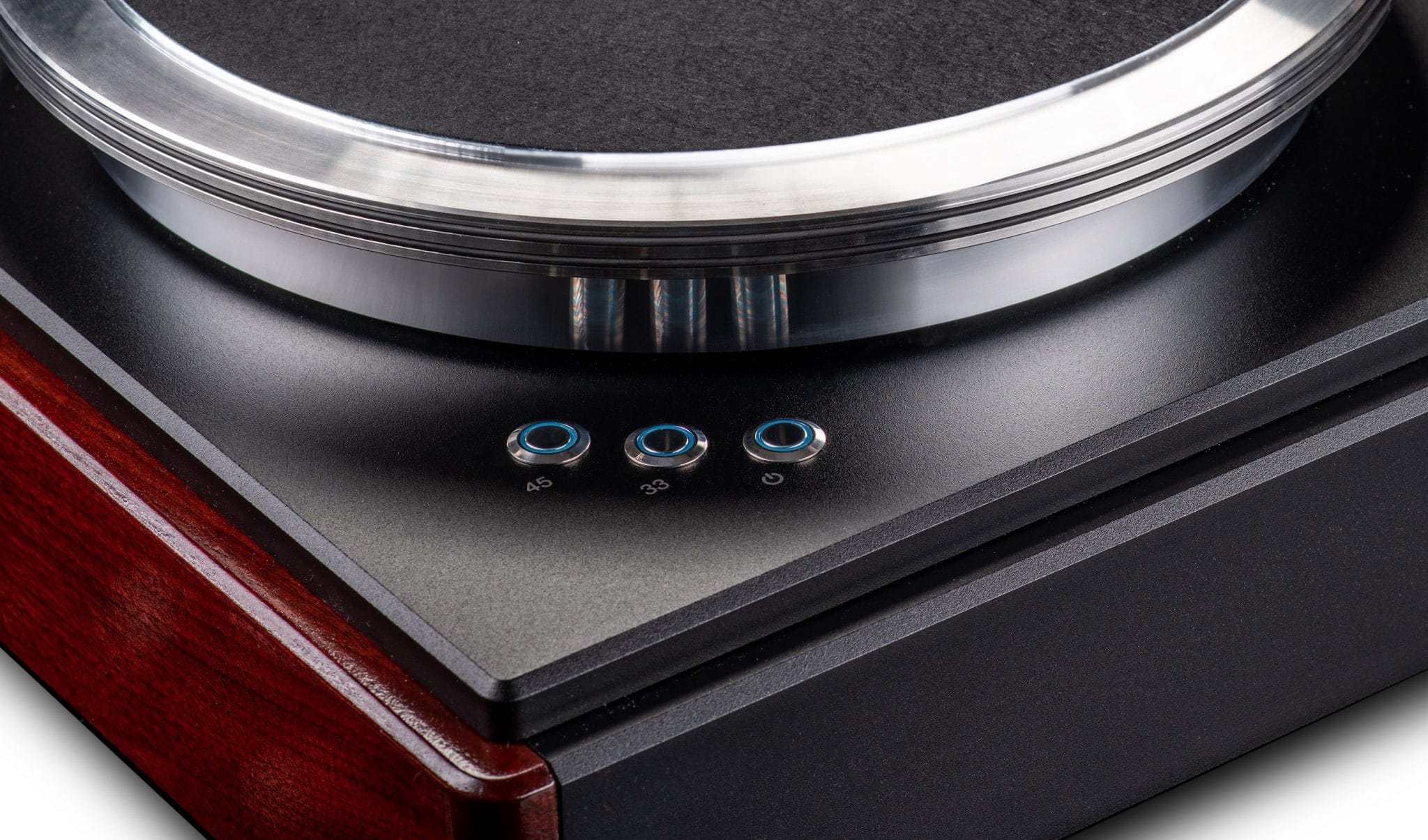
So I listened further and patiently waited. I didn’t have to wait for long. After a few seconds, on the right channel, the drummer hit his cymbal (and probably held it with his other hand to reduce reverb) and then he released his hand and hit it once more for a cymbal splash, hence ‘tap, tap, tap, tap, tap, splash’.
When he got to that ‘splash’ it took me aback. “Whoa, hang on, hang on. What was that you just did?” So I ran to the turntable, grabbed the arm (in a delicate way of course) and backed up a bit, ‘‘tap, tap, tap, tap, tap, splash’. Well. There it was again. That cymbal, my friends, seemed to have grown in radius by a foot and half because there was such a rich and deep response to this stick hitting an upturned saucer of metal. The abundance of shimmer over-flowed with a full-bodied and lush metallic swish sound. It sounded so good, I put the arm back to hear it once more.
Then Wilson’s vocal, always on that bright edge, changed. Her voice sat right on the stereo image, as you might expect. The HW-40 Anniversary allowed her voice to broaden left and right and, when it did that, more detail emanated from it. More shades, greater levels of gradation and a sense of refinement transformed her performance.
Then there was bass guitar (I’ll stop soon, I could right a book about this one track). The bass guitar did offer something truly new. Have you ever seen a bass guitarist in full flow? You may have seen him just quickly bring his hand back up or down the neck of the guitar. It’s a sudden thing that twists the notes that sometimes react like a caged animal in that the sound almost growls at you. Have you ever heard that effect? I hadn’t on this track until it was played by the HW-40. This is down partly to the direct drive mechanism, partly the heavy plinth and the solid wooden structure of the same. What I truly loved about this effect and why it had my waving my arms about in delight in a rather Italian manner was that it was done with just enough growl. It was subtle yet it grabbed your attention. I know some turntables that would have over-egged that particular pudding. They would have laid it on thick and screamed, “Look at me!” Not the HW-40 Anniversary. It just said, “Hey buddy, get this,” Then raised an eyebrow and inclined its head slightly. No more than that. Doing it that way was far more effective. Devastating, in fact. It added a sense of strength and driving guts to the whole track. It also added style to the presentation. Real style.
Ok, look let me change the record here. Otherwise I’m able to ramble on all night. Let’s rock out a bit with T2 and It’ll All Work Out in Boomland and the track, Morning. This is a direct drive turntable, right? So what was I looking for with a rock track? I’ll tell you what I didn’t want to hear. I didn’t want too much dynamism here and I didn’t want the HW-40 Anniversary to go overboard. I wanted restraint but lots of threat. I didn’t want obvious.
I didn’t get obvious. What I heard was a rainbow of subtle and tiny tonal variations that, when placed together, sounded like a fine dining Christmas hamper of delicate tastes and subtle flavours. The percussion offered variance in each drum sound while the acoustic guitar strums where rich in effort and pressure variations.
And yet. And yet. I wondered if I could improve matters further. Why? Because I had undertaken the sound tests without adding the supplied VPI stabiliser. When I picked up the VPI stabiliser to place over the spindle, a tiny grey cloud obscured the sunshine. That was because I had encountered this little tinker before when I reviewed the VPI Prime Scout. In that review, I described the turntable’s audio response with the stabiliser in place, “Adding the clamp increased frequency discipline and focus but it also reduced air and space in the mids and sounded a tad dry.”
That’s what I found here too. Really, why VPI insist on adding this stabiliser, which pays lip-service to the notion of a stabiliser but does no more, to a quality product like the HW-40 Anniversary is beyond me. It’s there as an after-thought. I recommend removing it from your listening room, using it as a paper weight and keeping it as far away from the HW-40 Anniversary as possible.
Instead I tried a quality stabiliser from HRS, the ADL which is the lighter stabiliser offering from the company and includes sound absorption technology. Using this variant, the HW-40 Anniversary provided even more focus and precision during treble-based cymbal taps while drum strikes now had greater character with added force behind that actual strike itself. In terms of pace, the entire song lifted its tempo and sped along at a fair clip while noise reduced further, removing a slight – almost imperceptible – coolness within the upper mids.
CONCLUSION
I’ve heard several direct drive turntables but the HW-40 Anniversary surpasses them all. It’s simply glorious. It’s the best direct drive design that I’ve ever encountered. It’s also quite possibly the best turntable I’ve ever heard. Firstly, because it offers authority with a light hand. It’s not a bully. It offers maturity and restraint. There is no sense of wanting to dominate the music here. This turntable is not ‘flash’, in terms of showing off or exhibiting itself. It never tries to impress.
Because of that one factor, I know that the VPI HW-40 Anniversary is a piece of true high-end hi-fi equipment. Only quality high-end hi-fi refuses to try. It wants you to come to it. To examine the music in detail and to rediscover the wonders within each song. If you don’t want to listen, really listen, then the HW-40 Anniversary doesn’t mind and won’t bother you. But if you pay attention and allow yourself to be drawn into this VPI design then it will reward you with an abundance of sonic treasures. The HW-40 Anniversary is an instant classic. In my eyes it has already attained legendary status.
Because of that, I have the honour of awarding it the ultra-rare Golden Groovy award. My goodness it deserves it.
HW-40 ANNIVERSARY TURNTABLE Price: £15,000 Tel: 0131 555 3922 Website: www.vpiindustries.com
GOOD: clarity, transparency, refined mids, rich treble, bass character, build quality, easy to install, aesthetics
BAD: the stabiliser
RATING: 10
[Don’t forget to check out my Facebook Group, The Audiophile Man: Hi-Fi & Music here: www.facebook.com/groups/theaudiophileman for exclusive postings, exclusive editorial and more!]
REFERENCE
Origin Live Sovereign turntable
Origin Live Enterprise 12″ arm
Van Den Hul Crimson XGW Stradivarius Cartridge
Soundsmith Paua Mk.II cartridge
Icon PS3 phono amplifier
Aesthetix Calypso pre-amp
Icon Audio MB845 Mk.II monoblock amplifiers
Quad ESL-57 speakers with One Thing upgrade
Blue Horizon Professional Rack System
Harmonic Resolution Systems Noise Reduction Components
All vinyl was cleaned using an Audio Desk’s Ultrasonic Pro Vinyl Cleaner

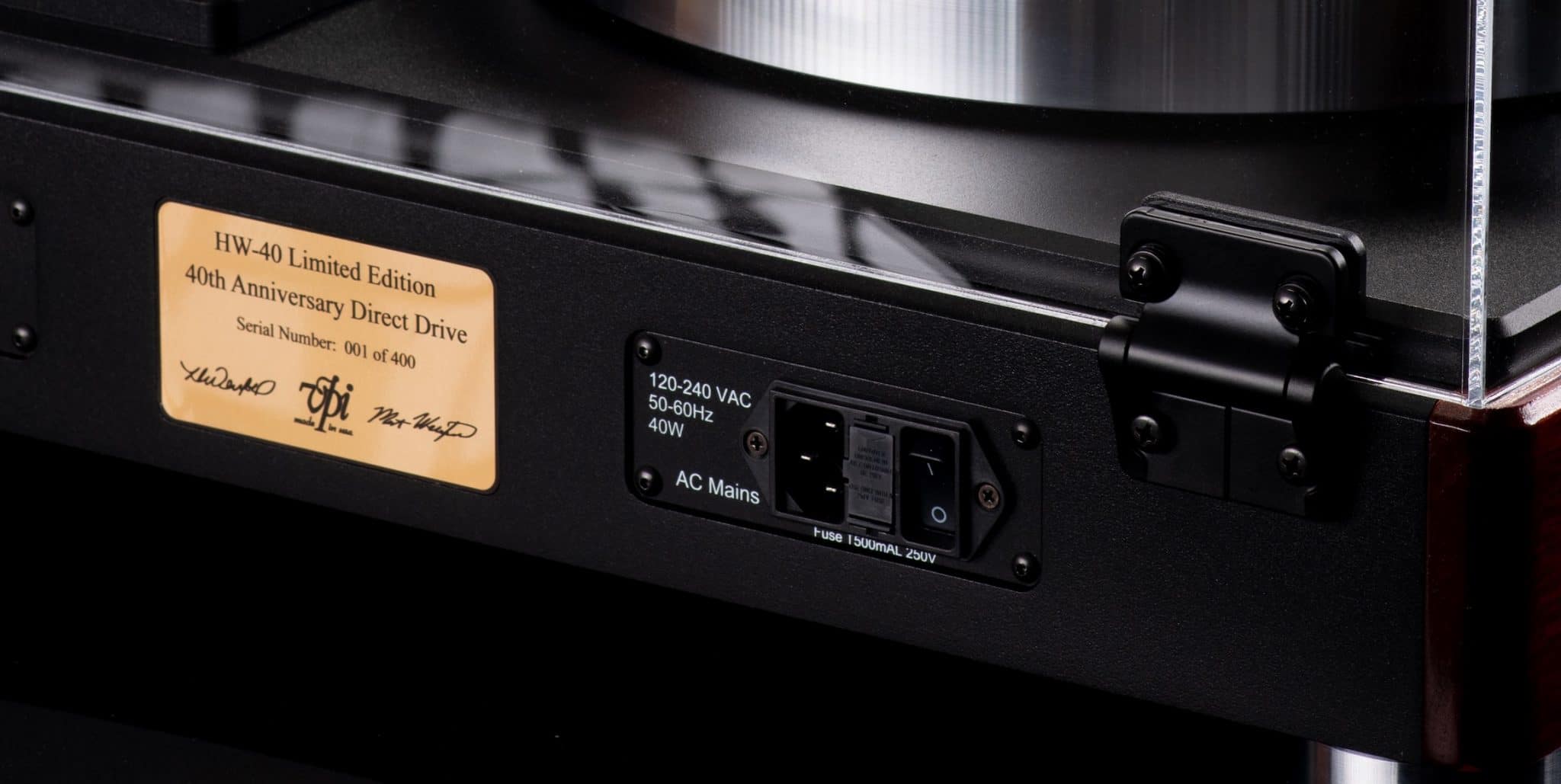
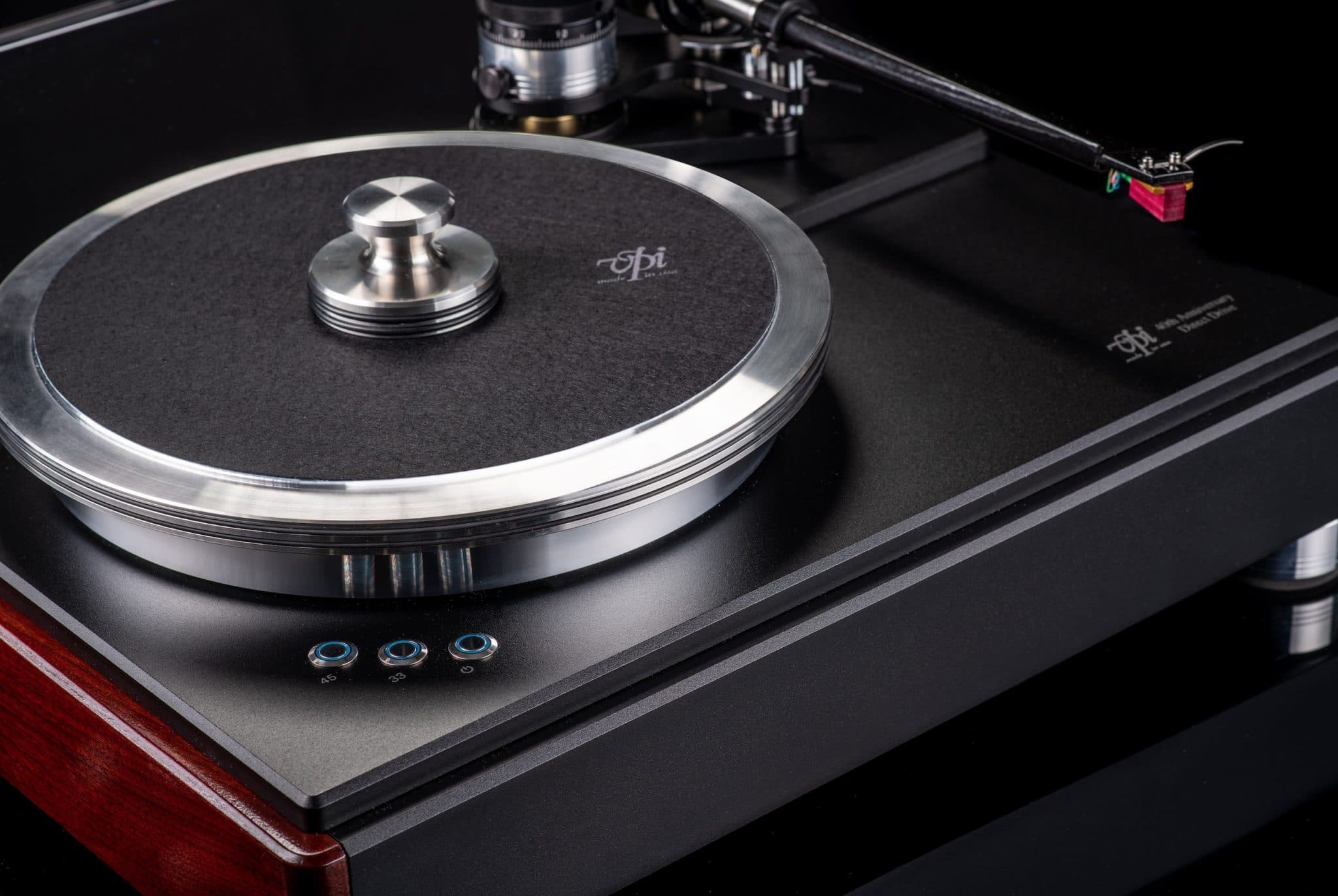
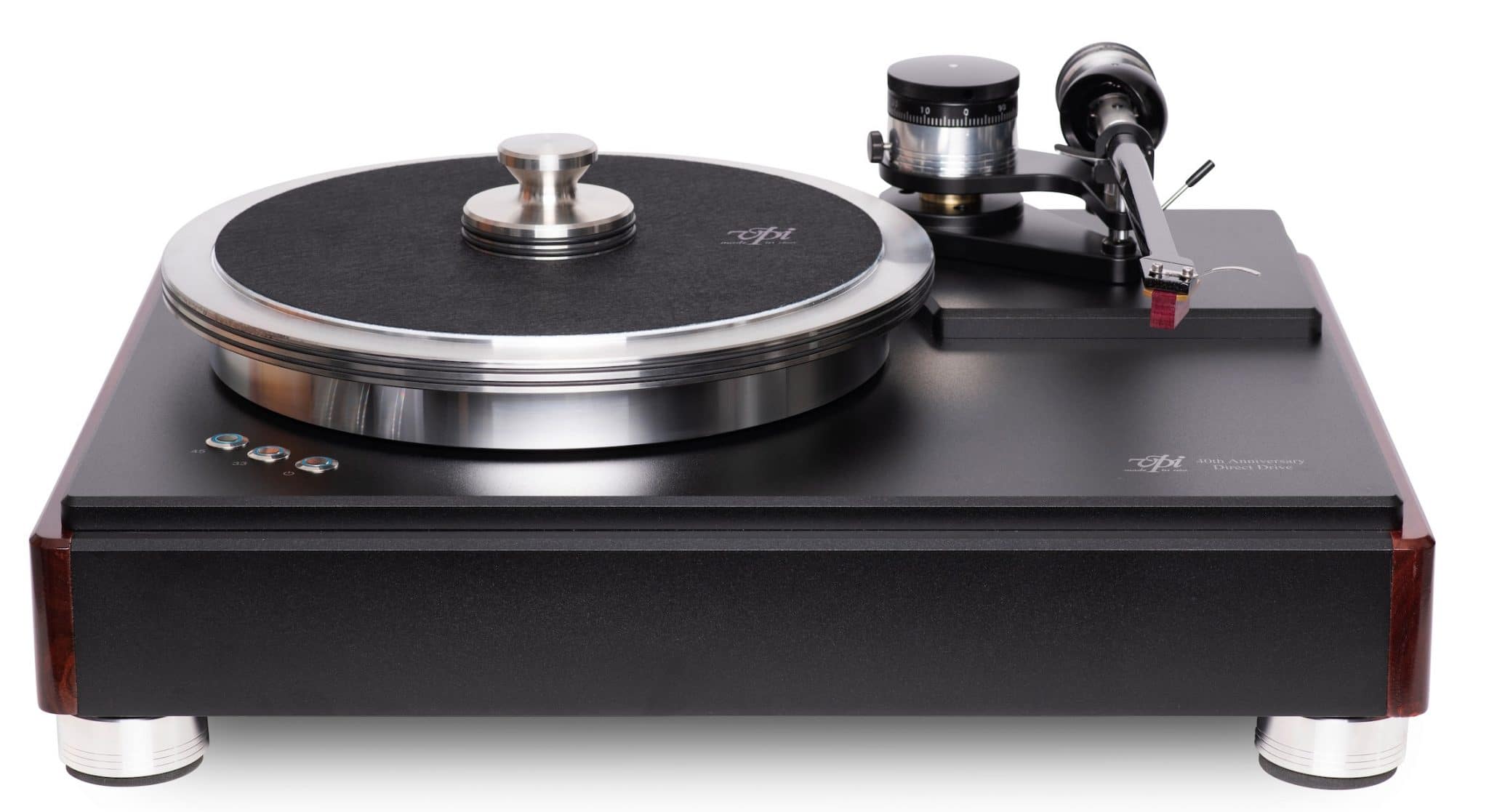
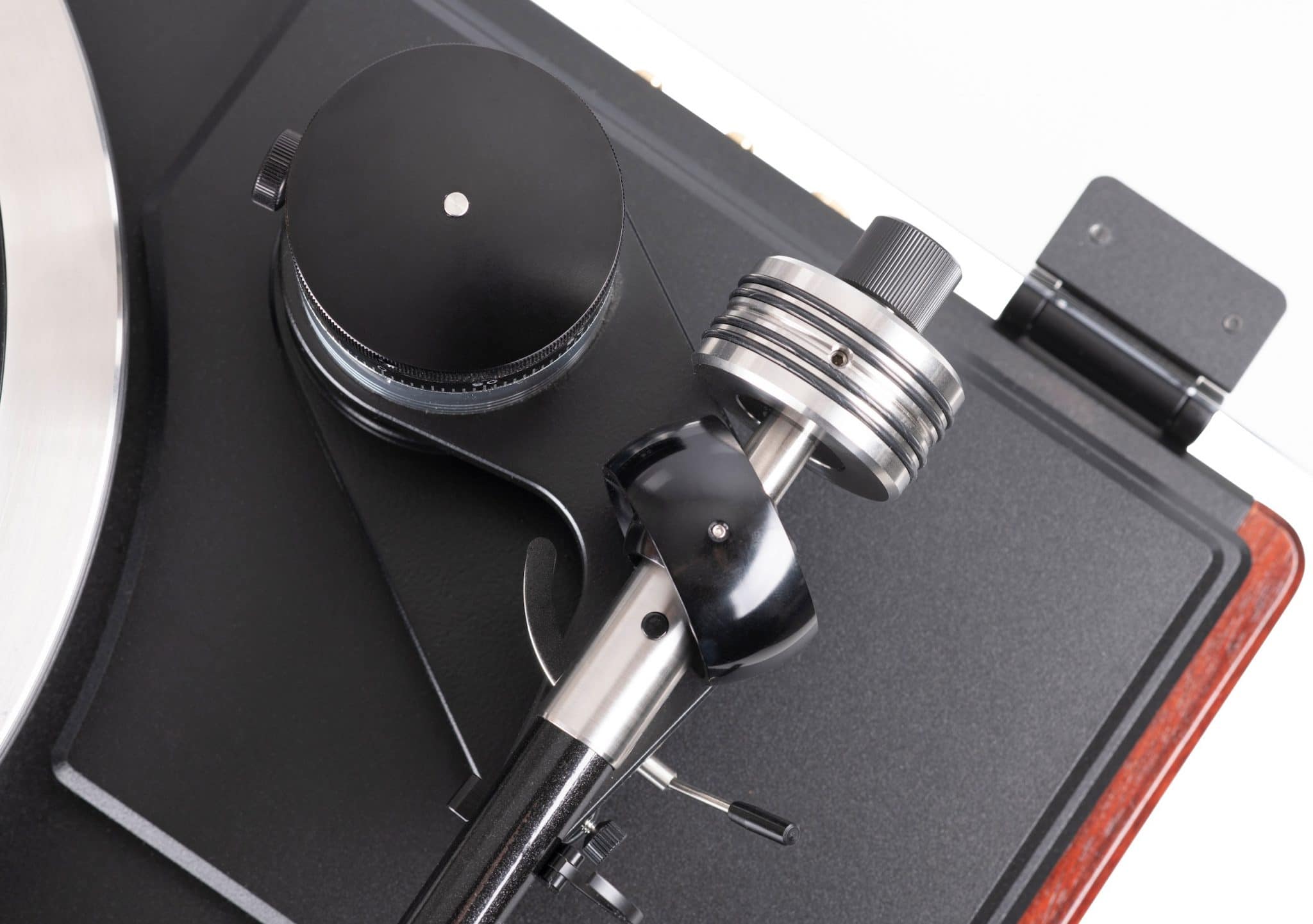
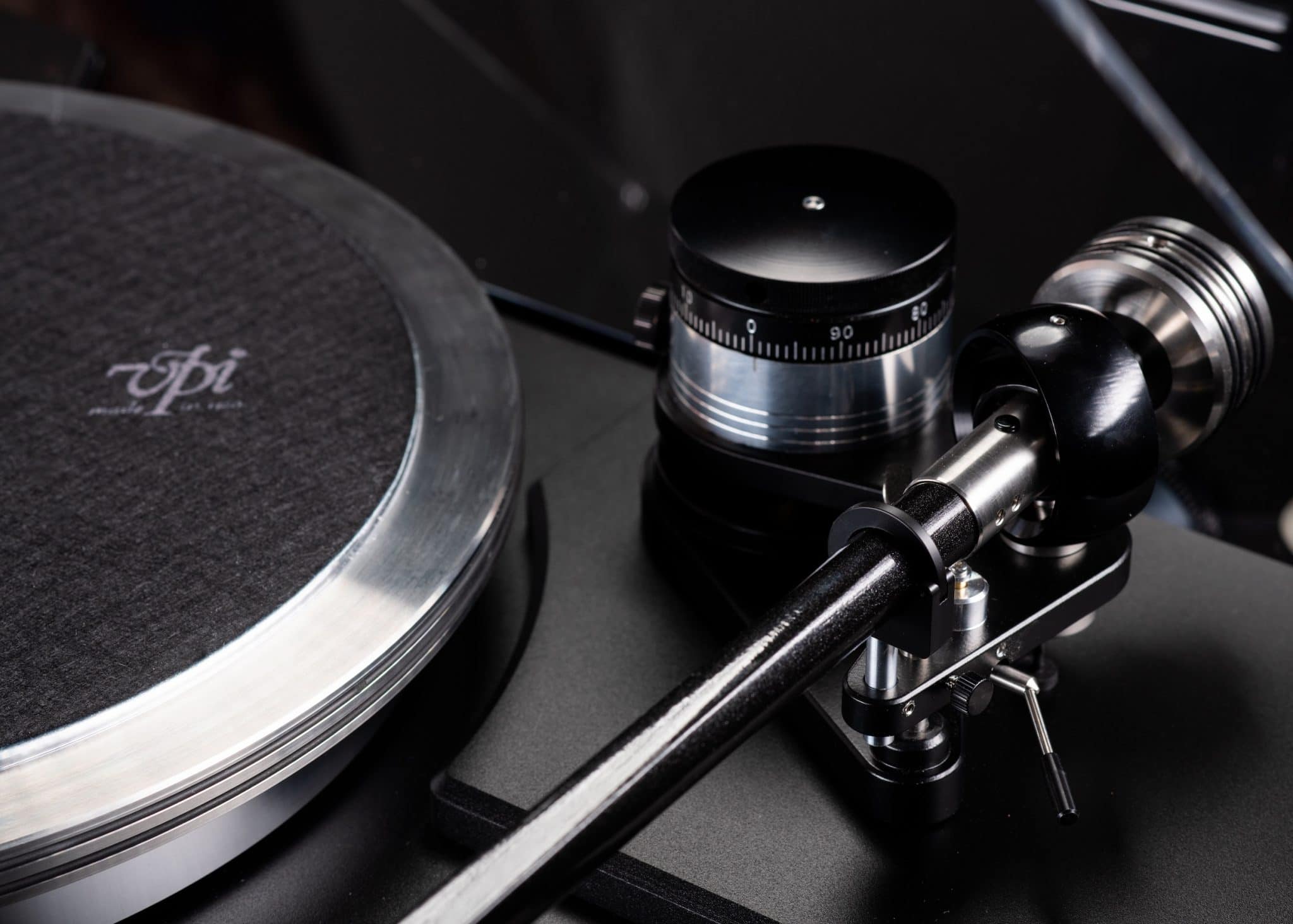
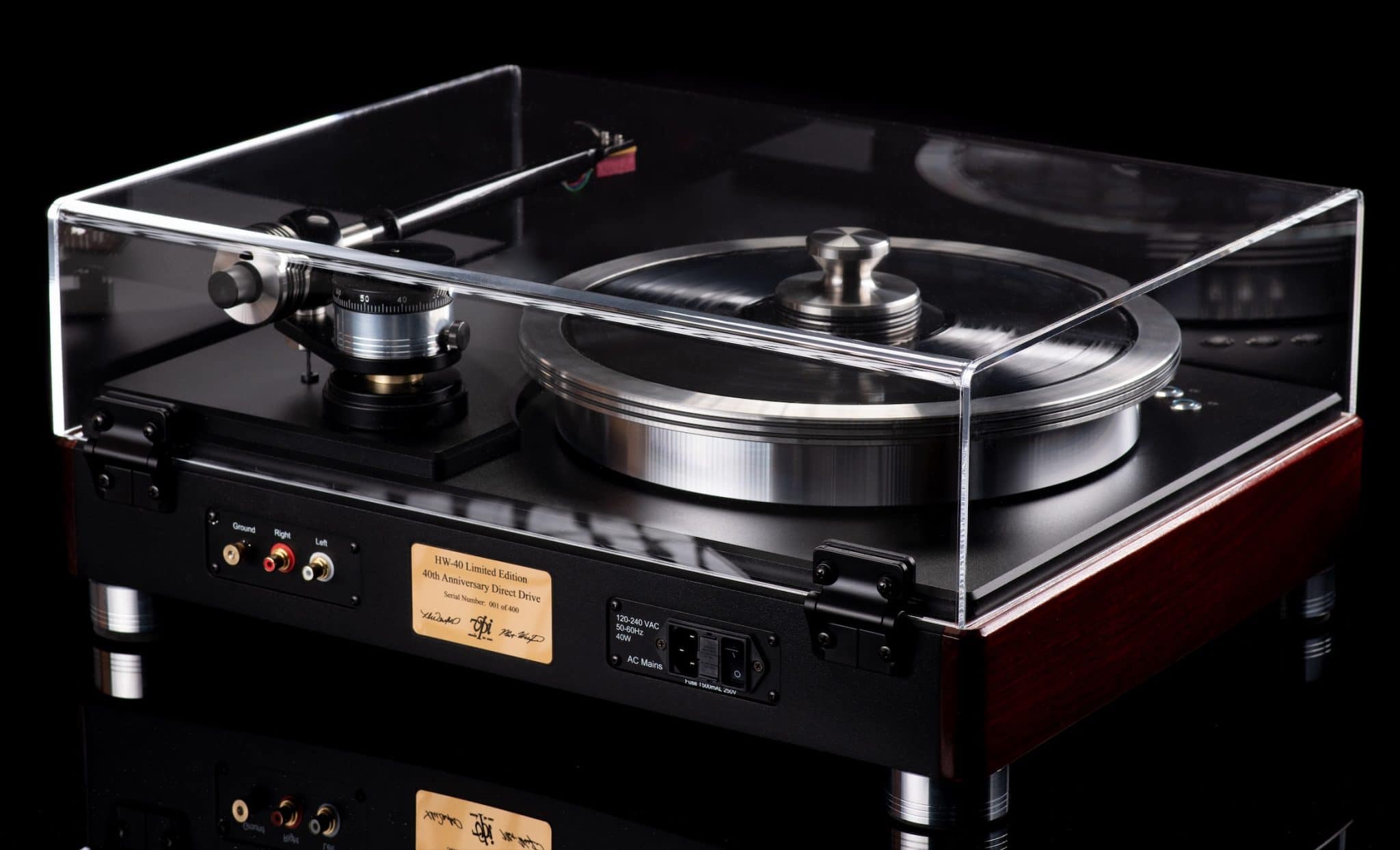
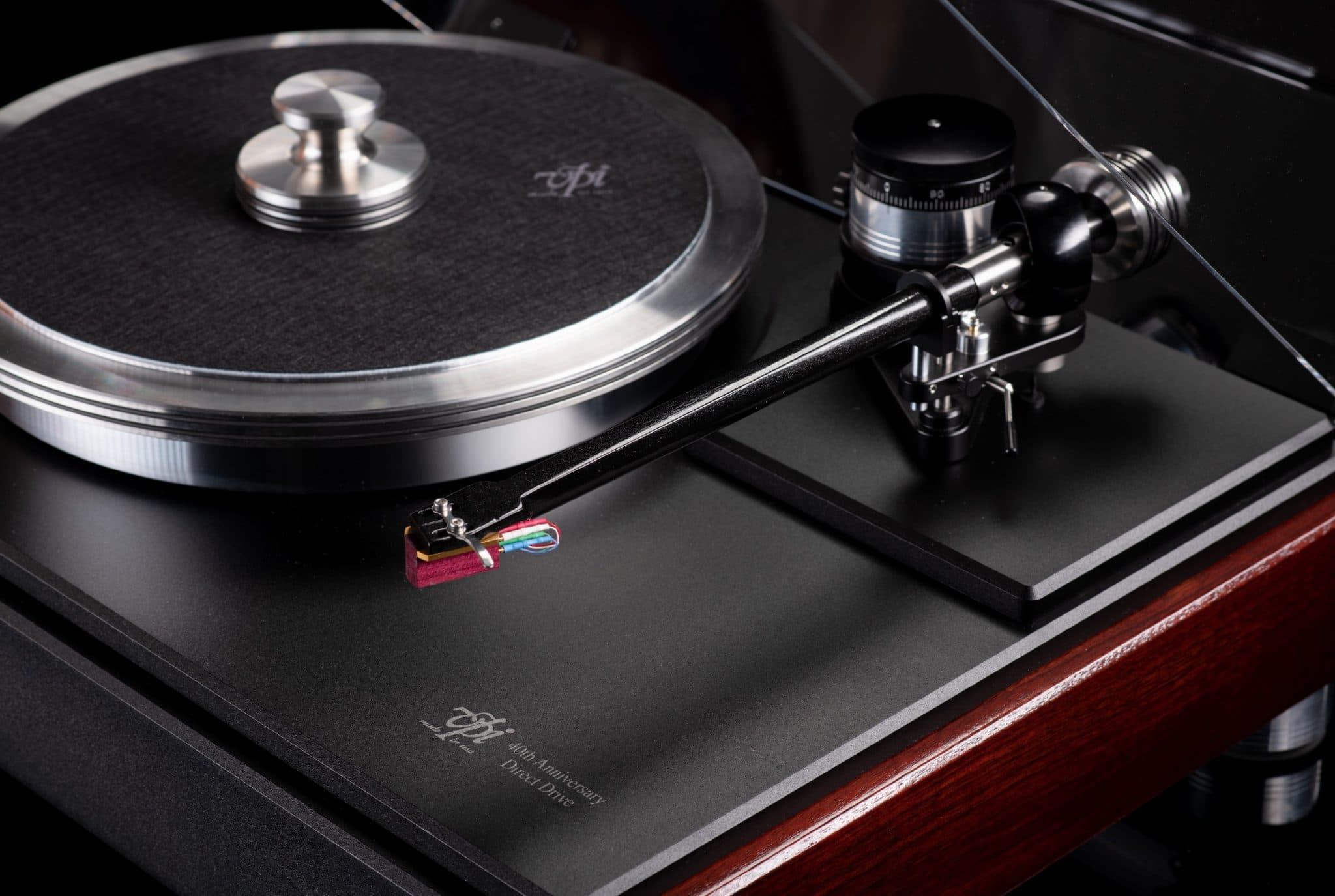
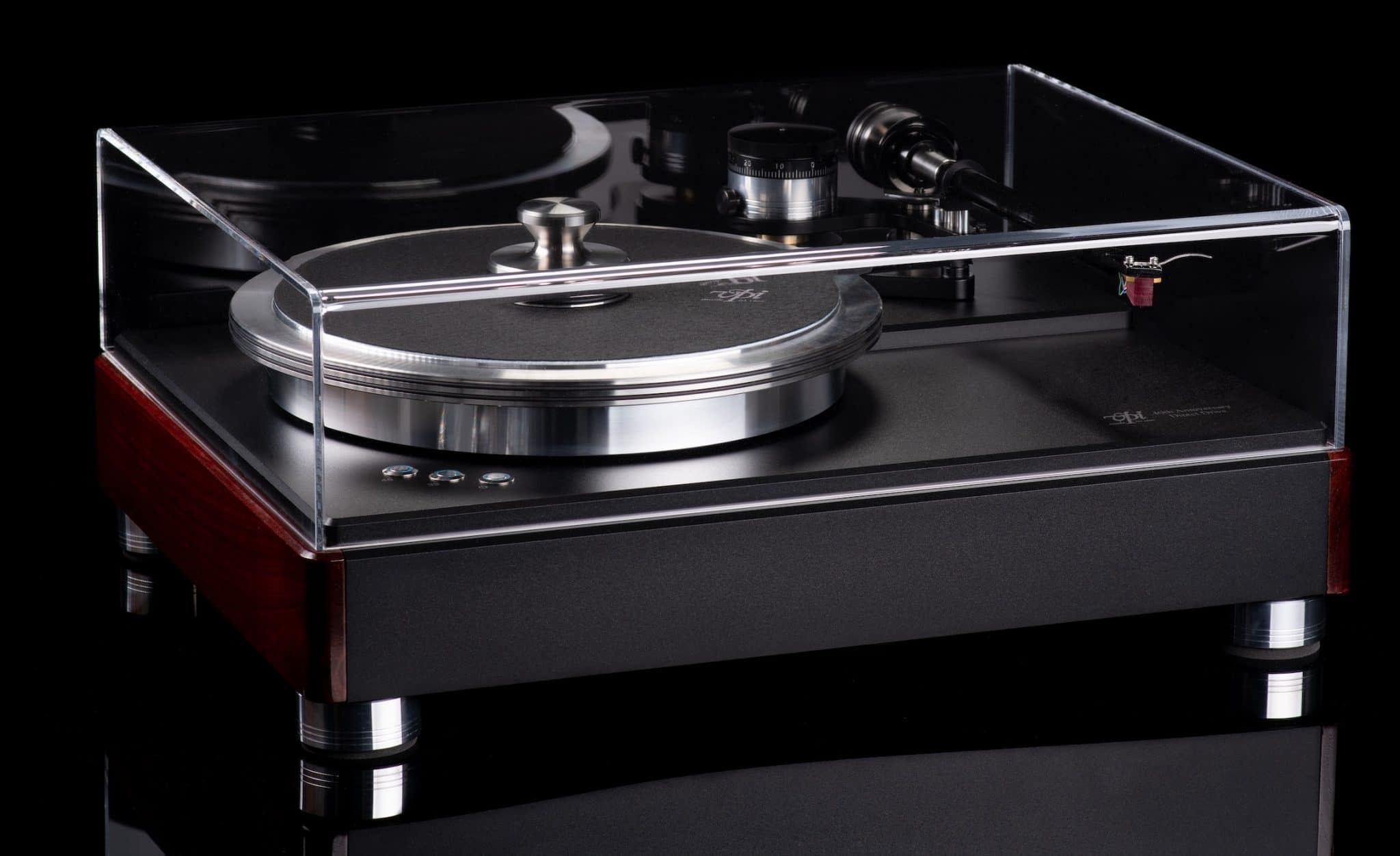
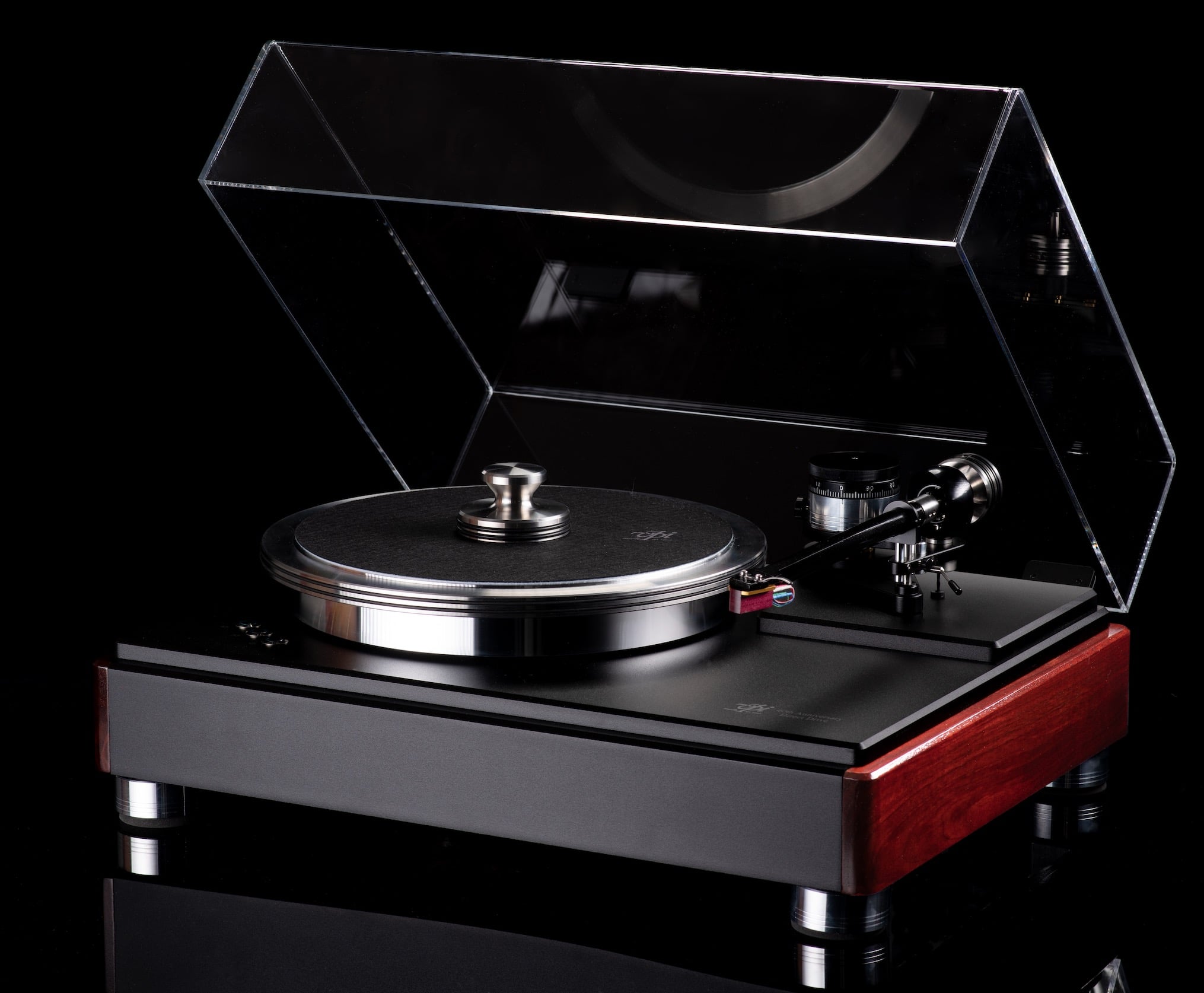
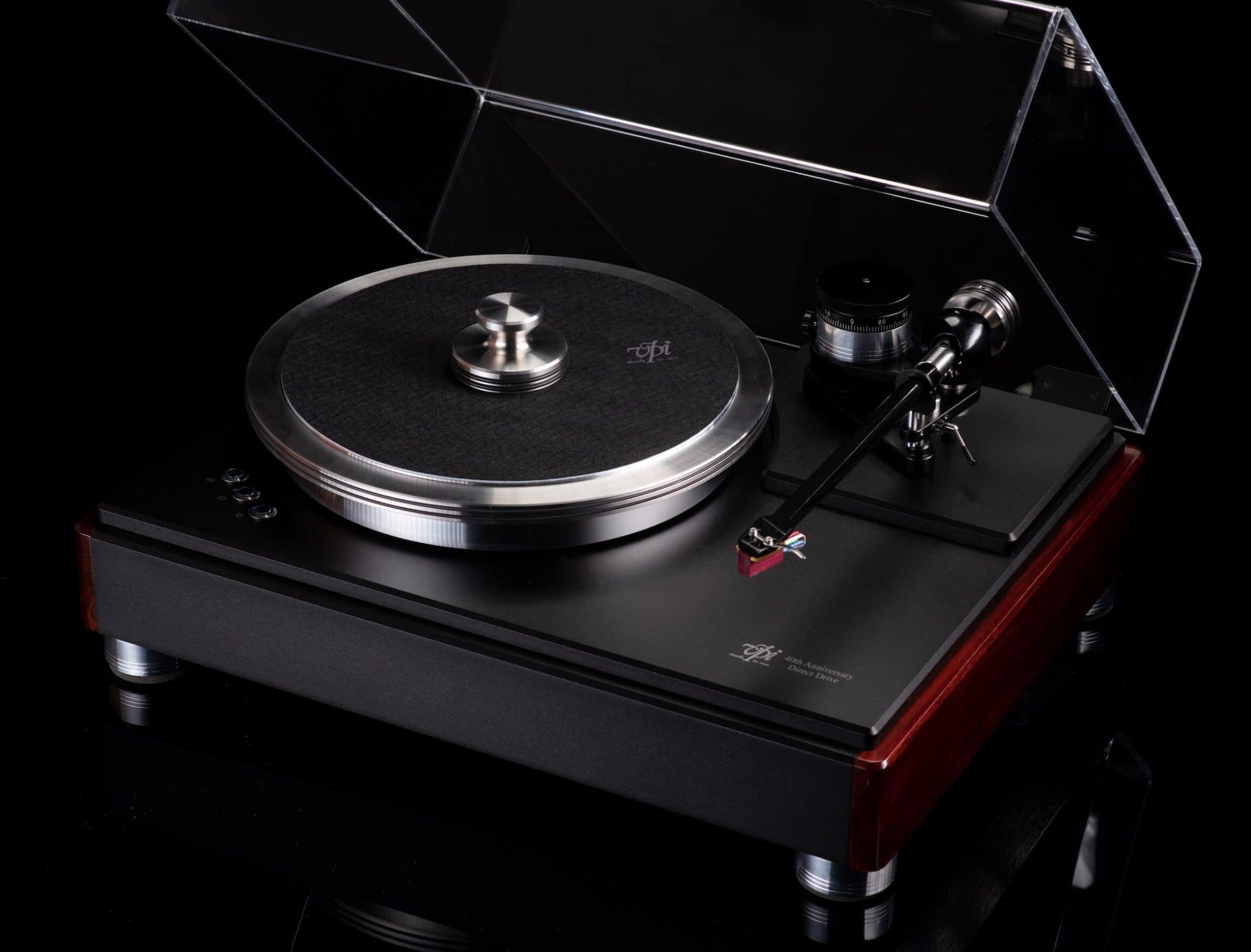
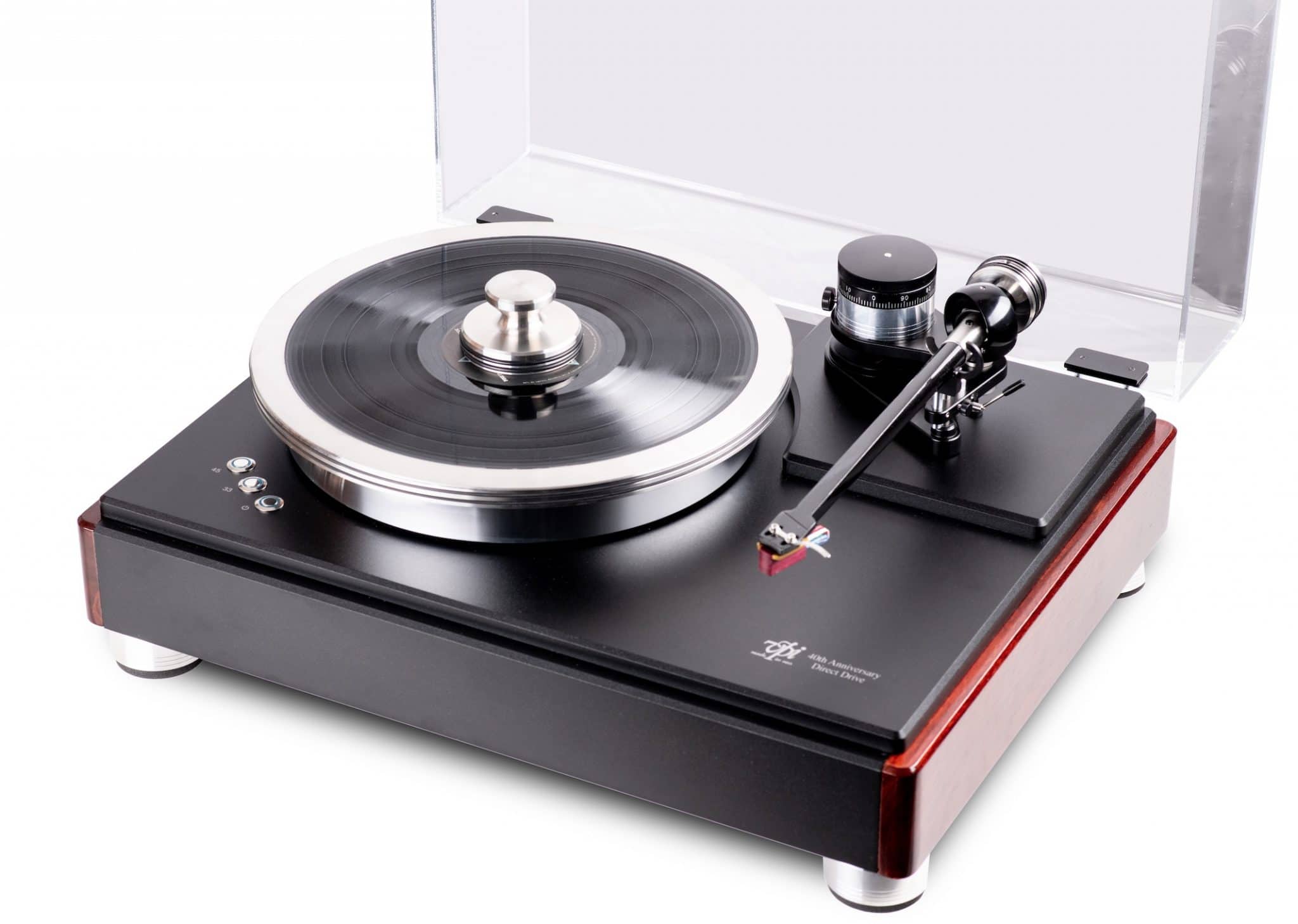
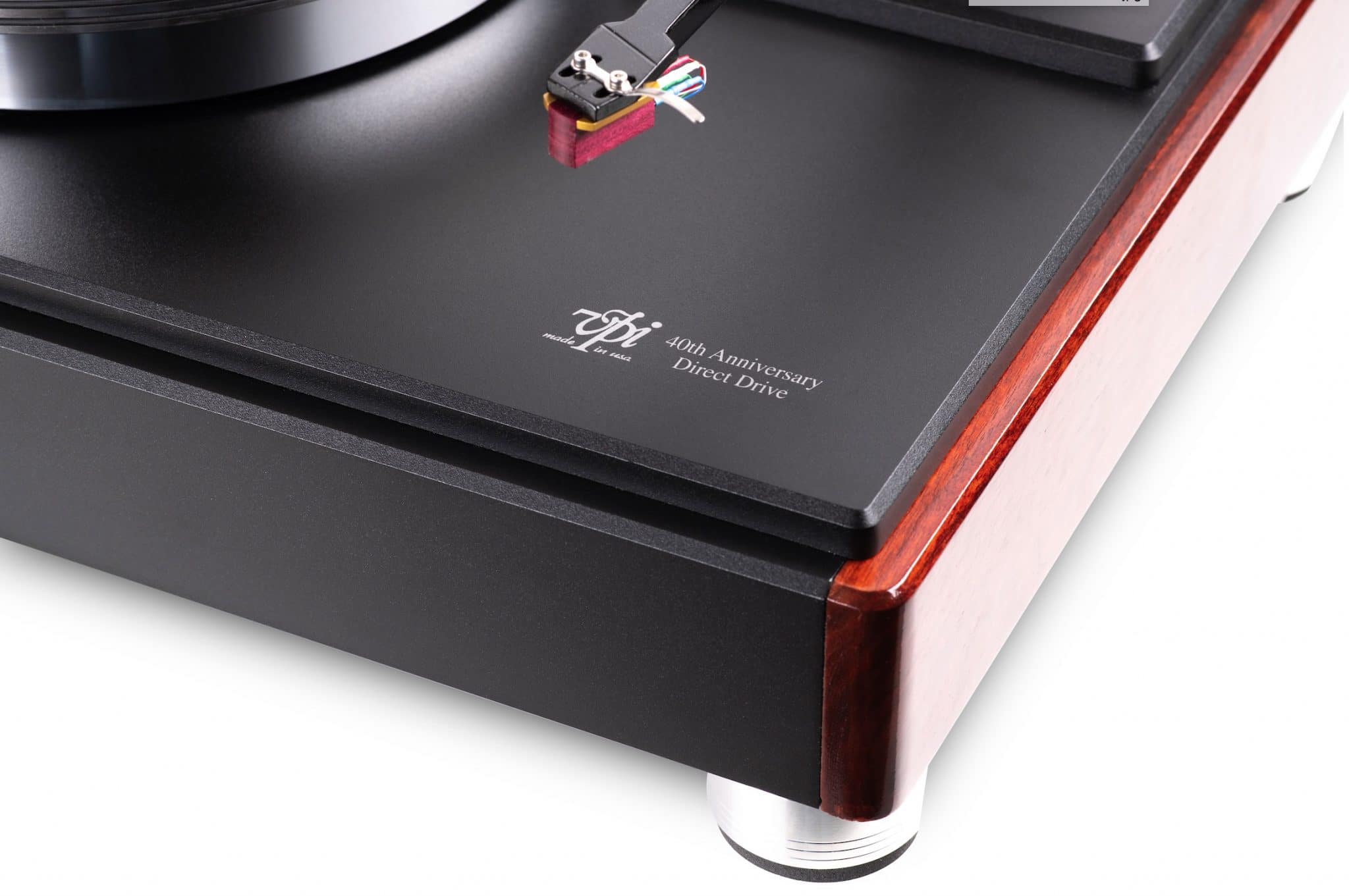
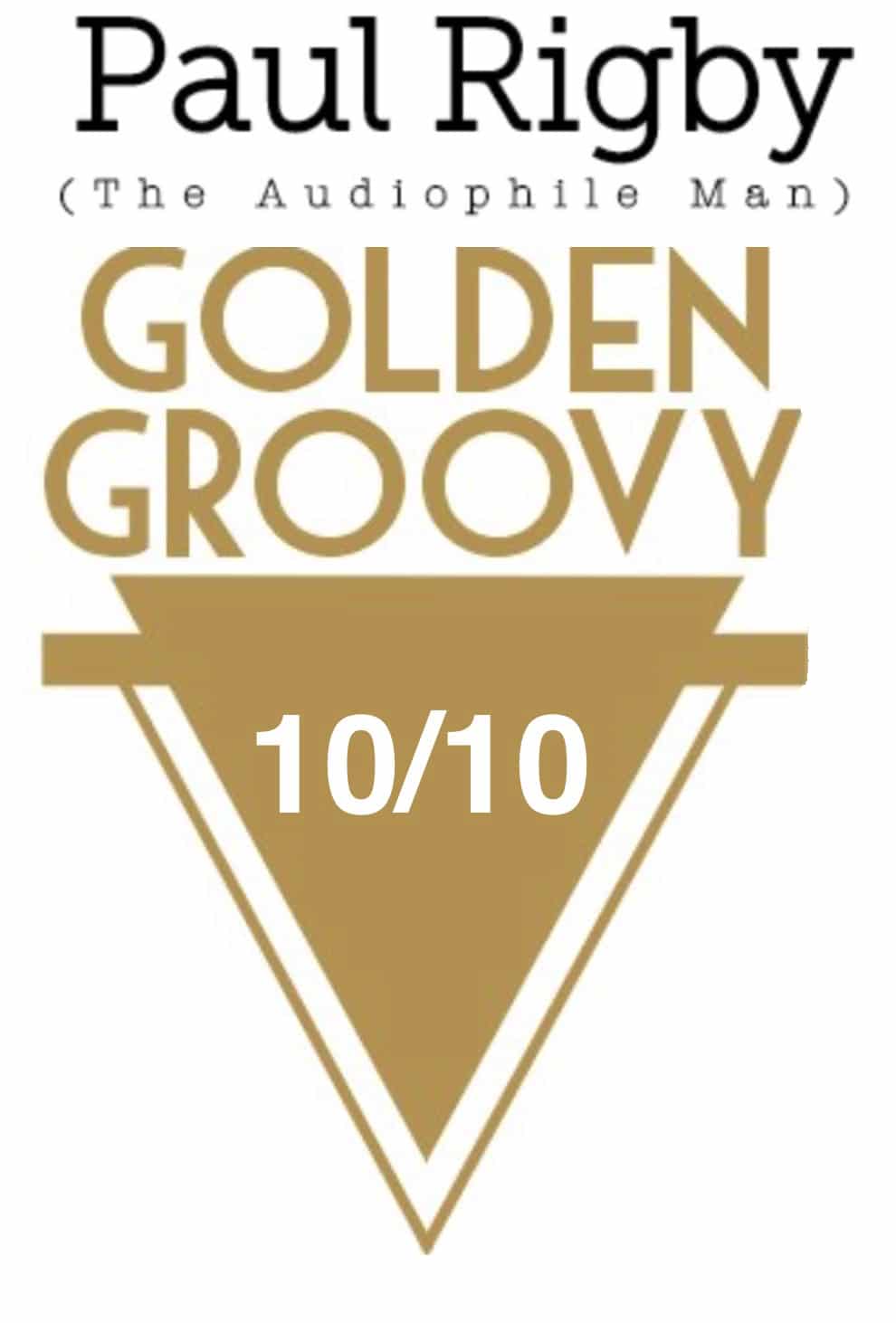

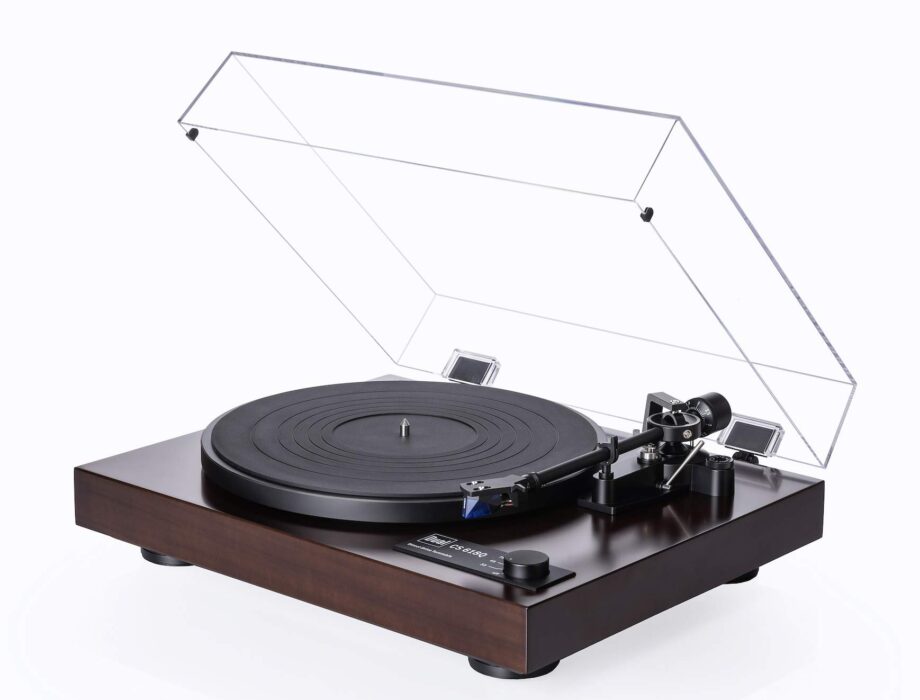
Hi Paul. Fantastic review. Your comments seem to mimic mine in regards to the stabilizer being used with the VPI Turntable in general. I have an original Scout with the acrylic platter and I’ve also found that the original Delrin screw clamp somehow makes the sound a bit dry and clinical.
I’ve tried other weights as well and I always prefer the musical presentation without any of them. I find it very interesting that you keep mentioning the HRS ADL in the VPI TT reviews as doing a great job.
MoFi has one called the Super Heavy Weight which incidentally is made by HRS and is slightly heavier than the ADL and a bit cheaper. Maybe you can review and compare them.
Very kind of you to say, Roger. Thanks. I’ve looked at many stabilisers and most tend to rely on weight/mass to do most of the job whereas HRS looks at sound absorbing materials as the primary tool. For the latter approach, Oyaide do a good job, incidentally. I did ask to review a host of Mo-Fi kit and they happily agreed and then…nothing 🙂 Not sure why. I did send a reminder but zilch. I’ll give them another poke.
You’re very welcome Paul. Maybe you can speak to Jim Davis of Music Direct who is a really nice guy and is affiliated with MoFi as well if I’m correct. I met Jim and his wife Bridget many years ago in Barbados. Lovely couple.
Yes, cuban b. That’s what I say.
Question for you: Did you align your cartridge with the supplied VPI jig or did you use an alignment gauge of your own? On your HW-40? I have an HW-40 on order and just as I was about to order a custom arc protractor from MintLP, VPI notified me that the pivot to spindle distance is 291mm on the HW-40 vs their customary 300mm on their other 12” arms. Obviously this equates to different factory alignment and etc. Just curious if you noticed this and/or found the same results? Thanks for your time!
Hi Desmond – actually, maybe you can help me out on this one when your turntable arrives. I used a couple of my own gauges because I didn’t hear anything from VPI re. the 291mm measurement. I didn’t hear any issues but maybe I got lucky with one of my gauges. Be interested to know how you get on though.
I actually messaged VPI before order the alignment gauge. Glad I did. They are supposed to give me more information soon. According to the specs on their website, their headshell angle and etc. indicates Baerwold or Lofgren alignment. The difference between 291mm and 300mm won’t really sound much different unless the cartridge is aligned wrong lol. But the HW-40 is advertised as having an “Anniversary” fat boy installed. So maybe a slightly shorter one is part of it. Maybe they were having clearance issues with the dust cover, etc. I’ll let you know as I know, but I figured i’d get this out there in case others are thinking of ordering a MintLp arc protractor. It would be bad if they assumed a 300mm pivot to spindle distance on the HW-40 as I almost did.
Thanks Desmond – please keep me updated and then hopefully that advice can remain under the review as a useful addendum.
nice blog sir…
Very nice of you to say subham – thank you.
How do you think this compares to the Motus stst? I guess this scored higher but feel like low torque DD is better engineering
Hi JB, the VPI does tackle the problem of brute force torque, as does the Motus. It just does that in a different way and I believe successfully. Both are quality turntables and both are highly recommended.
Hi Paul,
I’ve just come into possession of a new HW-40 and stumbled across your blog. The two recommendations I have received regarding stabilisers are the HRS ADH or the Origin Live Gravity One. Are you able to comment and help me decide?
Lucky man. Both of the designs you list are excellent. The Gravity will do more for you in sound terms, though. And avoid VPI’s own stabiliser like the plague 🙂
Thanks for the response Paul.
I was also just recommended the Mobile Fidelity Super HeavyWeight. Would you still recommend the Origin Live over the others listed?
Is it a case of not requiring the mass of the ADH or Mobile Fidelity’s stabilisers/weights?
The Origin Live is not about mass and weight, like trad stabilisers and clamps – it’s a sort of ‘drain’ design that’s been taken from a hyper-expensive Japanese model…whose name escapes me at the moment. So vibrations are damped and the nice floor is reduced. It’s the most effective device for the price, I’ve ever used and I have about a dozen clamps and stabilisers in my collection.
Hi Paul,
Sorry for my late response but, I very much enjoyed your review!!!
I purchased this Anniversary edition about a year ago from an original owner that never opened and setup the unit due to a financial situation that forced him to sell it. I have been operating it for about 200 hours this past year. I have read that TT platter bearings should be lubricated annually. But I am wondering about this TT with the PEEK thrust pad, maybe it is not necessary. I tried to take a look at the inverted bearing but when you pull off the platter there is the small turning platter that has the bearing inside that I do not know how to access. Can you give my any suggestions or help on this? Thank you very much for your consideration.
Best regards,
Tim
Hi Tim – are you based in the UK?
I am located in California.